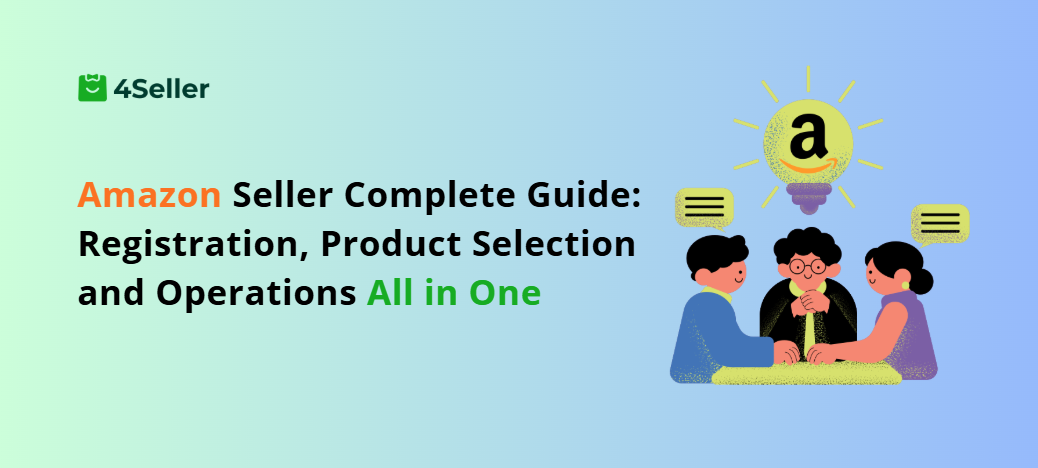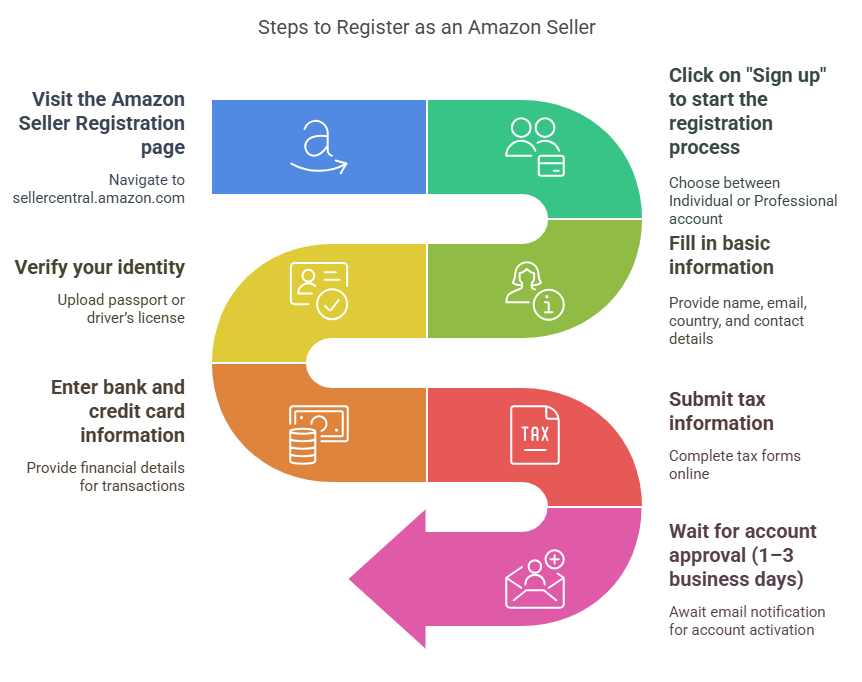Popular Posts
- Order Management
- TikTok Shop
- Temu
- About 4Seller
- Amazon
- Shopify
- Inventory Management
- Amazon MCF&FBA
- Amazon Shipping
- UPS
- FedEx
- DHL Express
- Listing Management
- Creator Bulk Invite
- GLS
- Seller Tips
- eBay
- Shein
- Marketplace News
- Royal Mail
- Amazon MCF
- Walmart
- Multi-channel Store
- Logistics Rule
- Shipping Integration
- Stripe Tracking Sync
- Poste Italiane
- UniUni
- USPS
- PayPal Tracking Sync
- OTTO
- Walmart WFS
- Yodel
- Kaufland
- BRT
- CaiNiao
- Chronopost
- CIRRO
- Correos
- Correos Express
- Deutsche Post
- DHL Parcel
- Etsy
- Evri
- GOFO
- Inventory Sync
- Beginner Tutorial
- DPD
- Shipping Label
- DHL
- FBM
- Platform Integration
- AliExpress
- 3PL
- Cdiscount
- OMS
- WooCommerce
Amazon Seller Complete Guide: Registration, Product Selection, and Operations All in One
 By Joline08 May,2025
By Joline08 May,2025Amazon remains one of the most promising online sales platforms globally in 2025. With over 300 million active users shopping on Amazon every month, individuals, small businesses, and established brands with retail experience are all leveraging this platform to expand their online sales channels.
For sellers based in Europe and North America, the simple registration process, mature logistics system, and high platform trust make entering Amazon easier than ever. Whether you're planning to start from your garage or hoping to digitalize your offline business, Amazon provides a clear and actionable path.
This article will provide you with a comprehensive beginner’s guide—from registering an account, selecting products, setting up logistics, to managing sales and improving conversion rates. We will also introduce key tools, such as 4Seller, to help you make data-driven decisions, avoid pitfalls, and get started more efficiently.
Step 1: Register Your Amazon Seller Account (Detailed Process)
Whether you're in the US, UK, Germany, or other European countries, the process of registering an Amazon seller account is generally the same. Below is the standard procedure for the US marketplace, with only slight differences in tax and bank information for other regions.
Information You Will Need to Prepare:
Before you begin the registration, make sure you have the following information ready:
- A valid email address
- Government-issued identification (passport or driver’s license)
- A valid credit card (for platform fees)
- Local bank account information (for receiving payments)
- Tax identity information (individual or company EIN / VAT number)
Detailed Registration Steps:https://sellercentral.amazon.com (for the US marketplace)
- Visit the Amazon Seller Registration page
You can choose between an Individual account or a Professional account:
- Click on "Sign up" to start the registration process
- Individual Account: No monthly fee, but a $0.99 fee per item sold.
- Professional Account: $39.99 per month, no per-item fees. This is ideal for sellers planning to sell more than 40 items per month.
- Fill in basic information
- Verify your identity
- Enter bank and credit card information
- Submit tax information
- Wait for account approval (1–3 business days)
Tips:
- Try to use the same name and address as on your bank account to reduce the chances of issues during verification.
- You can initially choose a professional account trial (Amazon sometimes offers the first 30 days for free).
- During the account review process, keep your phone and email available, as some users may be asked to verify their identity via video.
For local sellers, selecting the right category is more important than just chasing hot products. In 2025, consumers demand higher quality, faster delivery, and stronger brand perception, which presents an excellent opportunity for sellers with strong local fulfillment capabilities. Here are the top three categories on Amazon that continue to gain popularity, along with product selection suggestions:
1. Home & Kitchen
Market Trends:
- The growing home economy ensures stable demand for home goods.
- Home products that are aesthetic, practical, and reusable are especially popular among European and American consumers.
- Foldable storage boxes, drawer organizers, multifunctional kitchen tools (such as vegetable slicers)
- Scandinavian-style or minimalist decorative items
- Ability to partner with local suppliers for fast shipping (1-2 days delivery)
- Better understanding of local home style preferences (e.g., American farmhouse style vs. modern minimalist)
2. Health & Fitness
Market Trends:
- Rising health consciousness and home fitness trends are becoming the norm.
- "Lifestyle" products are increasingly popular, especially portable, stylish, and socially engaging fitness tools.
- Resistance bands, yoga mats, portable massage rollers
- Nutritional tools (e.g., water bottles, measuring containers that don't involve food)
- Avoid compliance issues in international shipping (such as items with magnets or packaging with chemical ingredients)
- Easier collaboration with local fitness influencers or micro-influencers for marketing
3. Pet Supplies
Market Trends:
- The trend toward humanizing pets is evident, with pet owners willing to spend on their "pet family."
- In 2025, per capita spending on pets is expected to grow by 6%, with dog and cat-related products having the highest share.
- Pet toys, portable feeders, travel accessories
- Pet beds, automatic water dispensers
- Ability to use FBA or local fulfillment to meet "urgent need" orders
- Better understanding of local regulations (e.g., specific materials that meet safety standards)
Step 3: FBA vs FBM – Which Fulfillment Model is Right for You?
Choosing the right fulfillment method is one of the key decisions in Amazon operations. Amazon offers two main fulfillment options: FBA (Fulfillment by Amazon) and FBM (Fulfillment by Merchant). Each method has its own advantages and disadvantages, and is suitable for sellers with different scales, resources, and goals.
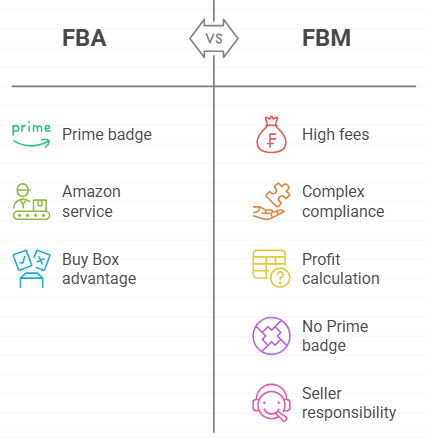
FBA means you send your products to Amazon’s warehouses in advance, and Amazon takes care of storage, packaging, shipping, and customer service.
Advantages:
- Enjoy Prime badge, which gives access to millions of Prime members, improving conversion rates
- Amazon handles customer service and returns, saving time and effort
- Easier to win the Buy Box
- Higher storage fees and long-term storage fees
- Products must comply with Amazon’s inventory requirements, making the process a bit more complex
- Multiple fee structures, requiring you to calculate profits in advance
- Sellers with certain sales expectations
- Beginners who want to save on labor and automate fulfillment
- Brands selling small, lightweight, high-turnover products
FBM means the seller fulfills the orders themselves or uses a third-party logistics company to handle the shipping process.
Advantages:
- More control, allowing flexible order handling based on customer needs
- No FBA storage costs in the beginning
- More suitable for customized or large items (e.g., furniture)
- No Prime badge, which may result in lower conversion rates
- Seller is responsible for returns and customer service, increasing operational pressure
- Slower shipping speed, which can affect account performance metrics
- Sellers with their own warehouse or local logistics resources
- Sellers dealing with special packaging, customization, or large items
- Startups looking to test the market and start with lower costs
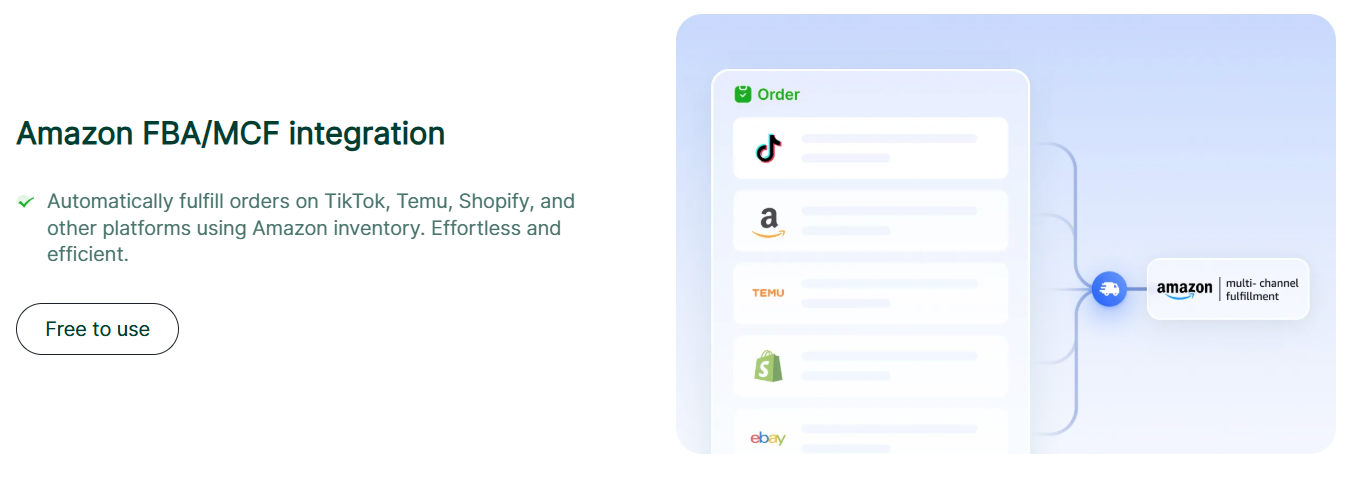
Helping tutorial: How to Automatically Fulfill Your Orders with Amazon FBA?
Helping tutorial: How to Automatically Fulfill Your Orders with Amazon FBM?
Helping tutorial: How to Automatically Fulfill Your Orders with Amazon FBM?
Step 4: Create High-Converting Product Pages (Listing Optimization Tips)
On Amazon, your product page (Listing) is your salesperson. Even if you choose a popular product, a poorly organized or unconvincing page will struggle to convert. Here are the key elements and practical tips for creating a professional, high-converting product page:
- Product Title Recommended format
Example (Home category): Minimal Nest Foldable Storage Box – Collapsible, Stackable Organizer for Closet or Bedroom – 3 Pack, Grey
Tips: Place the most important keywords within the first 50 characters to help with SEO Avoid keyword stuffing; unnatural phrasing can reduce click-through rates
- Bullet Points
Recommended structure:
- Functional selling point (e.g., “【Durable Structure】Made of thickened PP material, can hold up to 20kg”)
- User experience (e.g., “【Easy to Use】No tools required, folds/unfolds in 5 seconds”)
- Use case (e.g., “【Versatile】Ideal for bedroom, bathroom, garage storage”)
- Safety/Environmental/Quality certifications (e.g., “BPA-free, eco-friendly, CE certified”)
- Local shipping advantages (e.g., “Fast delivery, shipped from US warehouse, arrives in 2 days”)
- Product Images
Image suggestions:
- Main image: Pure white background, no borders, no text
- Image 2-5: Show product features and size comparisons
- Image 6: Show lifestyle image in use
- Image 7: Comparison image (showing advantages over similar products)
- Image 8: Local shipping/packaging image (builds trust)
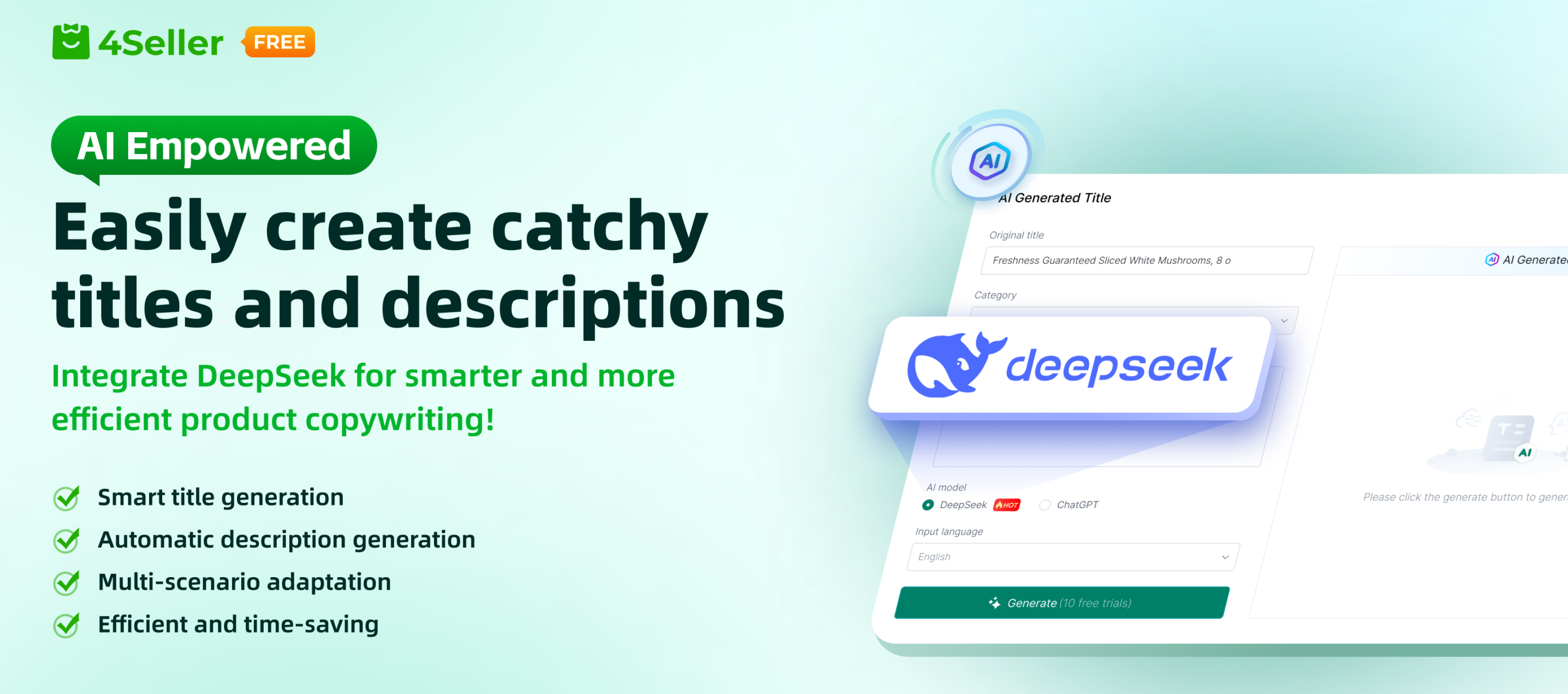
Helping tutorial: AI-Generated Listing Content via 4Seller × DeepSeek R1!
- Product Description / A+ Content
Description suggestions: Use simple, natural language, avoid jargon Highlight the product’s core value and brand ethos Include an FAQ-style section (beneficial for SEO and increasing trust)
- Keyword Optimization (Search Terms)
- Do not repeat words already in the title or bullet points
- Use long-tail keywords (e.g., “portable storage for kids room”)
- Limit to 250 bytes, avoid commas, repetition, and spelling errors
Step 5: Master Core Amazon Metrics & Recommended Tools
Many new sellers think that once their products are listed, they can just “wait for sales,” but real growth comes from ongoing data monitoring and fine-tuning. Amazon provides a lot of backend data, and here we focus on the top 5 key performance indicators, along with practical tools, to help you systematically boost sales and profits.
1. Conversion Rate (Unit Session Percentage) Metric meaning: How many visitors actually make a purchase?
This is the core metric to assess whether your Listing is effective. Low conversion rates may indicate unappealing images, unclear titles, or a non-competitive price.
Target benchmarks:
- New product phase: 10%–15%
- Stable sales phase: 15%–25%
- 4Seller Listing Diagnostics: Detect title, image, and keyword mismatches
- Amazon A/B Testing (Manage Your Experiments): Test main image or title effectiveness
This is the key metric to evaluate whether your ads are profitable. If ACOS exceeds your profit margin, you need to adjust your keywords or bidding strategy.
Ideal value:
- 20%–35% (depending on category profit margins)
- Amazon Ads Backend + 4Seller Ad Tracking: Integrate organic + ad sales trends, discover inefficient keywords
- Automatic vs. Manual Ads Data Comparison: Optimize budget allocation
This button affects over 90% of order attribution. If you don’t win the Buy Box, even if customers add your product to the cart, they might check out a competitor’s product.
Improvement strategies:
- Use FBA for fulfillment
- Maintain good order fulfillment and customer service records
- Set reasonable pricing (not necessarily the lowest, but stable)
User reviews accelerate conversions. For new products, it’s recommended to actively gather 5–10 high-quality reviews using compliant methods.
Tool recommendations:
- Amazon Early Reviewer Program / Vine Program (available on some sites)
- 4Seller Review Monitoring: Spot negative feedback keywords and optimize products or respond to users
Inventory buildup leads to high FBA storage fees and can impact Listing ranking.
Ideal benchmarks:
- Fast-moving items: 1–2 turnovers per month
- Home/pet products: Inventory refresh every 2–3 months
- 4Seller Inventory Alert System: Forecast stockout risks and optimize restocking pace
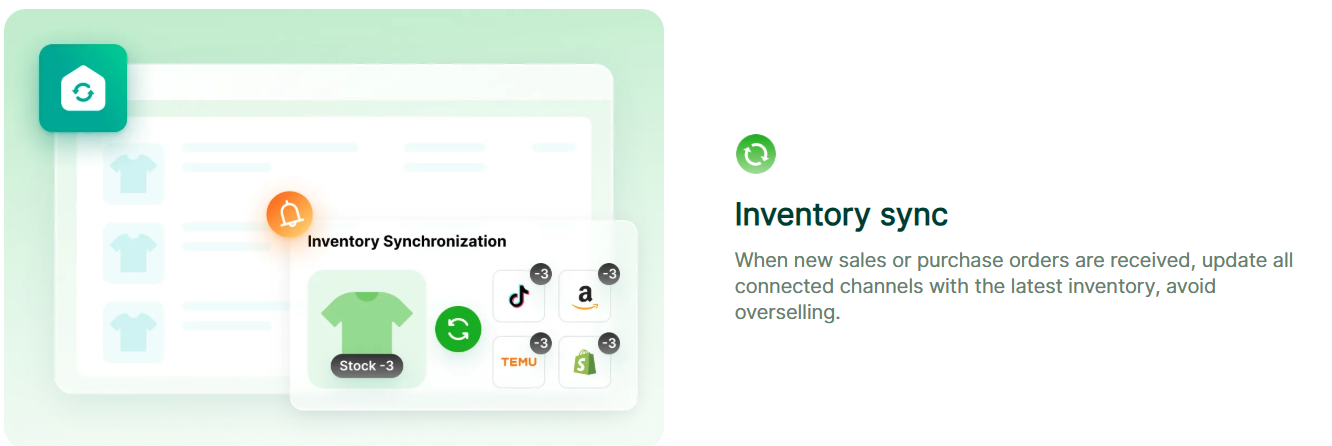
- Amazon Inventory Performance Index (IPI): Official measure of inventory health
When starting as an Amazon local seller, many people fall into “seemingly obvious” traps that can waste time and money. Here are the most common mistakes and practical advice from successful sellers for you to consider.
Common New Seller Mistakes
- Listing dozens of products from the start Many new sellers hope to “win by volume,” only to find their resources spread thin and ad budgets diluted, making it hard to drive sales for any product. Advice: Focus on 1–3 core products in the beginning, prioritize gathering reviews and sales.
- Ignoring Listing optimization and focusing only on ads If the product page is poorly written or the images are unattractive, boosting ad spend won’t help. It only leads to high ACOS and low conversions. Advice: Optimization of both ads and listings must go hand in hand; if clicks don’t convert, you’re burning through your budget.
- Not monitoring inventory, leading to stockouts after a surge in sales Some new products suddenly gain volume, but sellers fail to restock in time, leading to stockouts → ranking drops → recovery becomes difficult. Advice: Use inventory alert tools or set minimum stock reminders to plan your restocking cycle at least 3 weeks in advance.
- Trying to target the national market right away without starting locally Many local sellers aim for nationwide shipping in the beginning, neglecting the advantages of local delivery speed, review accumulation, and ad testing. Advice: Focus on precise delivery and ads within local states or major cities first, then expand nationally after accumulating ratings.
- “Product selection is more important than marketing” Let data guide your decisions, not gut feeling. Products with high click-through rates and low return rates are the best products.
- “Listing optimization is always the starting point” Review your main images, keyword coverage, and descriptions every month. Competitors are changing, and so should you.
- “Cash flow management is critical” Do not blindly purchase inventory. Clearly define your turnover cycle and inventory costs before each purchase.
- “Reviews = social currency” Without reviews, conversion relies on luck. Gaining early positive reviews through compliant methods is more effective than price slashing.
- “Tools are not luxury; they are your moat” The sooner you use professional tools like 4Seller, the sooner you can avoid guesswork in operations and let data drive your decisions.
Whether you’re transitioning from Etsy or eBay, or entering online sales for the first time, if you leverage your local advantages and use data-driven product selection and operations, you can stand out on a massive platform like Amazon.
4Seller will continue to provide comprehensive data support, product insights, ad optimization advice, and operational tools to help you transition from zero to one, from side hustle to brand.
Validated Customer Outcomes
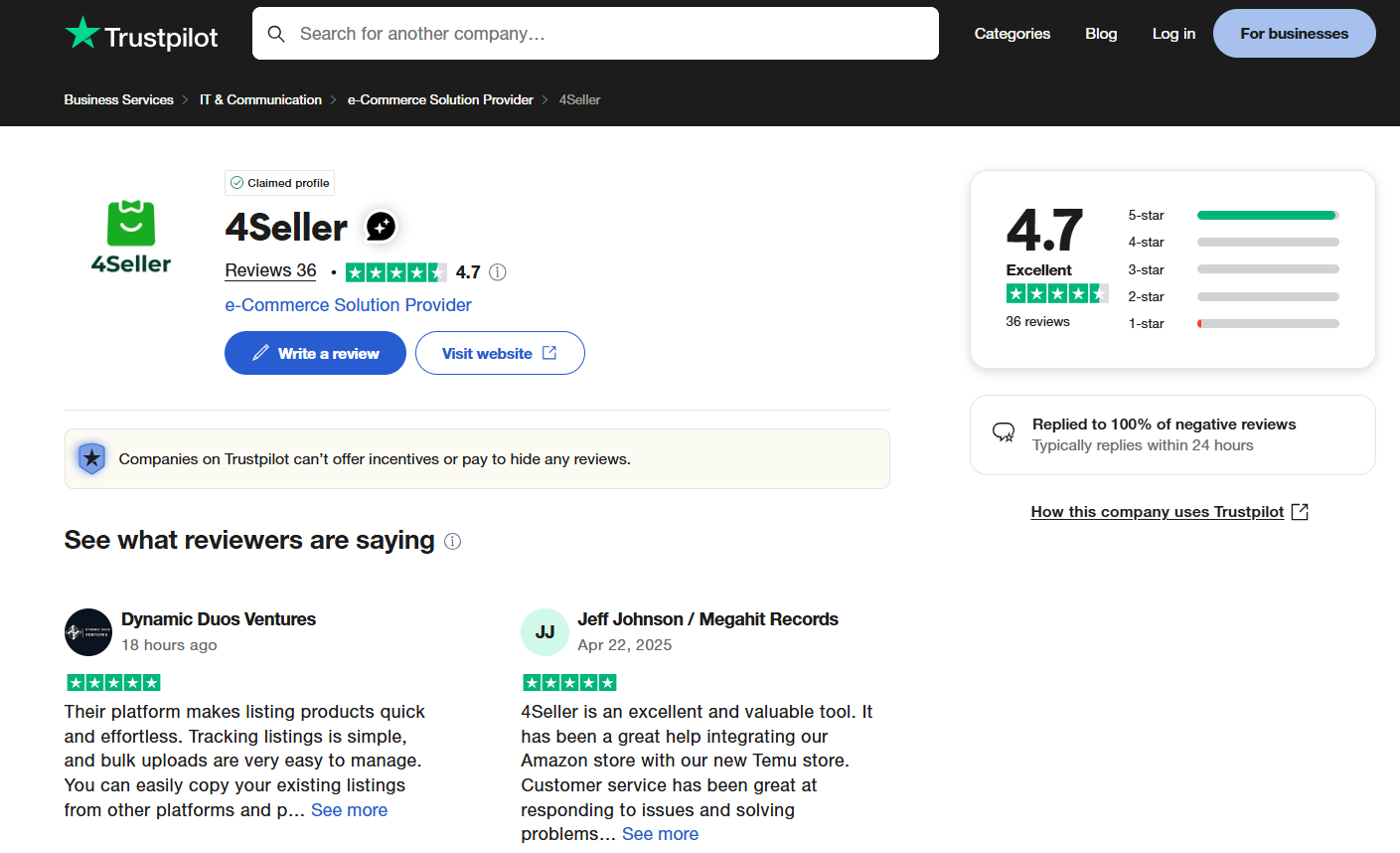
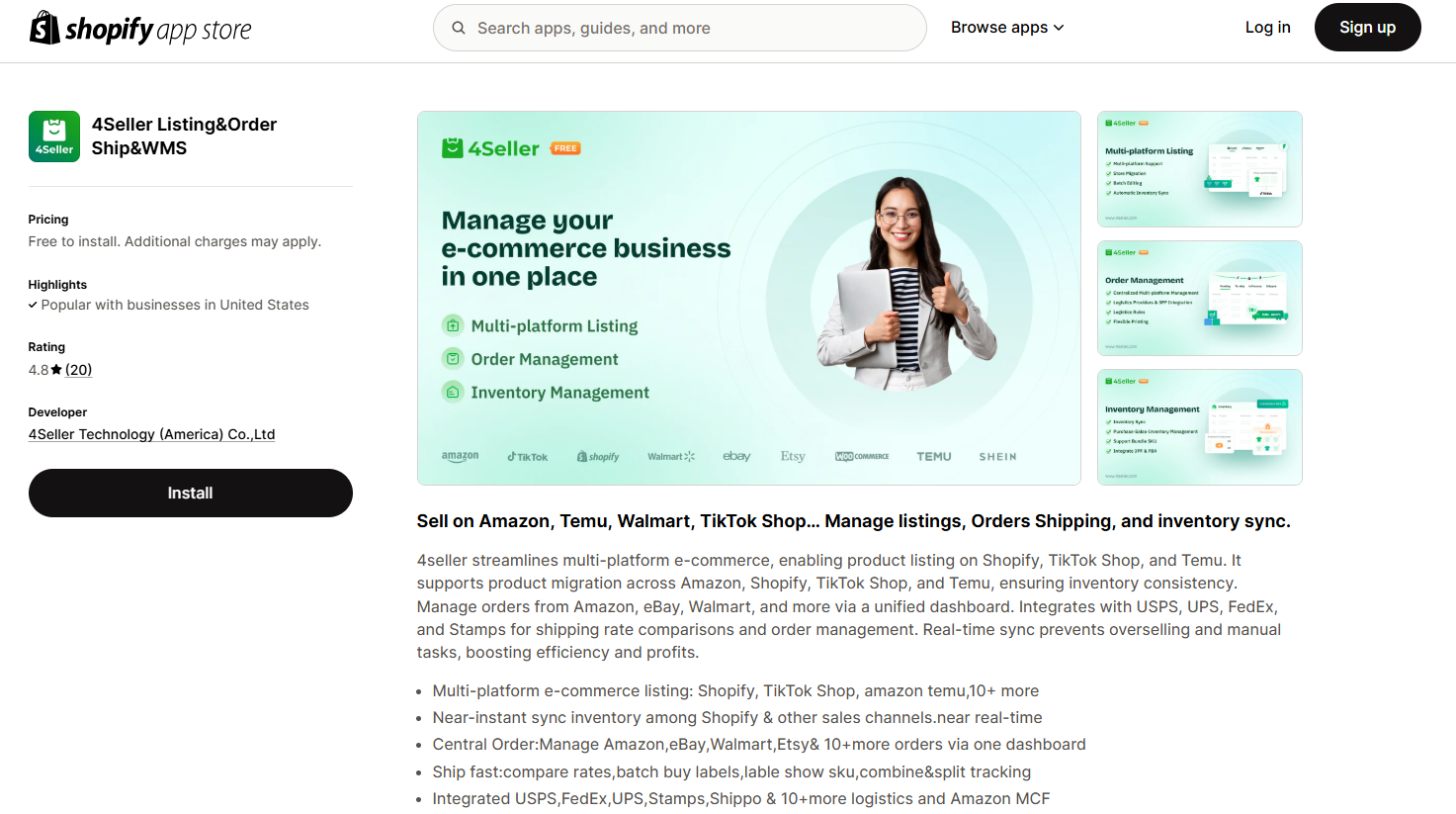
Verified User Testimonial: “Connecting our Shopify store with Temu using 4Seller was incredibly straightforward. We migrated 400 + SKUs in less than 90 minutes, and the automated inventory sync reduced manual errors by 75%. Our sales on Temu have seen a remarkable increase since the integration!” —Amy Evangeline, Multichannel Retailer
For more detailed performance metrics and case studies, check verified customer reviews on Trustpilot. You can also visit the 4Seller Shopify App Store profile.
Topics
All Topics
- Order Management
- TikTok Shop
- Temu
- About 4Seller
- Amazon
- Shopify
- Inventory Management
- Amazon MCF&FBA
- Amazon Shipping
- UPS
- FedEx
- DHL Express
- Listing Management
- Creator Bulk Invite
- GLS
- Seller Tips
- eBay
- Shein
- Marketplace News
- Royal Mail
- Amazon MCF
- Walmart
- Multi-channel Store
- Logistics Rule
- Shipping Integration
- Stripe Tracking Sync
- Poste Italiane
- UniUni
- USPS
- PayPal Tracking Sync
- OTTO
- Walmart WFS
- Yodel
- Kaufland
- BRT
- CaiNiao
- Chronopost
- CIRRO
- Correos
- Correos Express
- Deutsche Post
- DHL Parcel
- Etsy
- Evri
- GOFO
- Inventory Sync
- Beginner Tutorial
- DPD
- Shipping Label
- DHL
- FBM
- Platform Integration
- AliExpress
- 3PL
- Cdiscount
- OMS
- WooCommerce
Popular Posts
- 17 Dec,2024
Popular Posts
- 17 Dec,2024
Back to top
